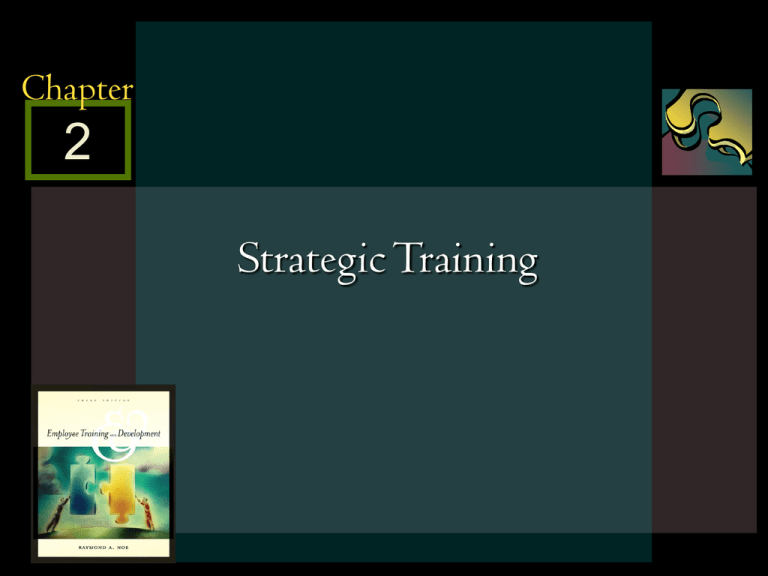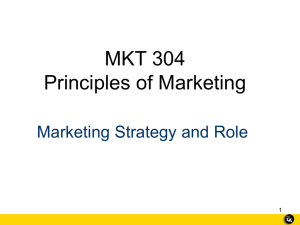
Chapter
2
Strategic Training
McGraw-Hill/Irwin
© 2005 The McGraw-Hill Companies, Inc. All rights reserved.
2-1
Introduction: Business Strategy
A plan that integrates the company’s goals,
policies, and actions
The strategy influences how the company uses:
physical capital (plants, technology, and equipment)
financial capital (assets and cash reserves)
human capital (employees)
The business strategy helps direct the company’s
activities to reach specific goals
McGraw-Hill/Irwin
© 2005 The McGraw-Hill Companies, Inc. All rights reserved.
2-2
Strategy impacts training with a strong
influence on determining: (1 of 2)
The amount of training devoted to current or
future job skills
The extent to which training is customized for:
the particular needs of an employee,
or developed based on the needs of a team, unit, or
division
Whether training is restricted to specific groups
of employees or open to all employees
McGraw-Hill/Irwin
© 2005 The McGraw-Hill Companies, Inc. All rights reserved.
2-3
Strategy impacts training with a strong
influence on determining: (2 of 2)
Whether training is:
planned and systematically administered, or
provided only when problems occur, or
spontaneously as a reaction to what competitors are
doing
The importance placed on training compared to
other human resource management practices such
as selection and compensation
McGraw-Hill/Irwin
© 2005 The McGraw-Hill Companies, Inc. All rights reserved.
2-4
Evolution of Training’s Role
Training Event
Create and Share
Knowledge
Performance
Result
Learning
Emphasis
Business Need
McGraw-Hill/Irwin
© 2005 The McGraw-Hill Companies, Inc. All rights reserved.
2-5
Evolution of Training’s Role: Learning
The acquisition of knowledge by individuals,
employees, or groups of employees
Willing to apply that knowledge in their jobs in
making decisions and accomplishing tasks for the
company
McGraw-Hill/Irwin
© 2005 The McGraw-Hill Companies, Inc. All rights reserved.
2-6
Evolution of Training’s Role: Knowledge
Explicit Knowledge:
Human and Social
Knowledge:
What individuals or teams
of employees know or
know how to do
Knowledge that can be
formalized, codified, and
communicated
Tacit Knowledge:
Structured Knowledge:
Company rules, processes,
tools, and routines
McGraw-Hill/Irwin
Personal knowledge based
on individual experience
Difficult to explain to
others
© 2005 The McGraw-Hill Companies, Inc. All rights reserved.
2-7
Intellectual Capital
Cognitive Knowledge
(know what)
Advanced Skills
(know how)
System Understanding
and Creativity
(know why)
Self-Motivated
Creativity
(care why)
McGraw-Hill/Irwin
© 2005 The McGraw-Hill Companies, Inc. All rights reserved.
2-8
The Strategic Training and Development
Process:
Business Strategy
Mission
Values
Goals
Strategic Training
and Development
Initiatives
McGraw-Hill/Irwin
Diversify the
Learning Portfolio
Training and
Development
Activities
Improve Customer
Service
Accelerate the
Pace of Employee
Learning
Capture and Share
Knowledge
Use Web-Based
Training
Make Development
Planning Mandatory
Develop Websites for
Knowledge Sharing
Increase Amount of
Customer Service
Training
Metrics that Show
Value of Training
Learning
Performance
Improvement
Reduced Customer
Complaints
Reduced Turnover
Employee
Satisfaction
© 2005 The McGraw-Hill Companies, Inc. All rights reserved.
2-9
Decisions a company must make about how
to compete to reach its goals:
1. Where to compete?
In what markets, industries, products will we compete?
2. How to compete?
On what outcome or differentiating characteristic will
we compete?
3. With what will we compete?
What resources will allow us to beat the competition?
How will we acquire, develop, and deploy those
resources to compete?
McGraw-Hill/Irwin
© 2005 The McGraw-Hill Companies, Inc. All rights reserved.
2 - 10
Strategic Training and Development
Initiatives and their Implications (1 of 4)
Strategic Training and
Development Initiatives
Diversify the Learning
Portfolio
Expand Who is Trained
Accelerate the Pace of
Employee Learning
McGraw-Hill/Irwin
Implications
Use new technology for training
Facilitate informal learning
Provide more personalized learning opportunities
Train customers, suppliers, and employees
Offer more learning opportunities for non-managerial
employees
Quickly identify needs and provide a high-quality learning
solution
Reduce the time to develop training programs
Facilitate access to learning resources on an as-needed
basis
© 2005 The McGraw-Hill Companies, Inc. All rights reserved.
2 - 11
Strategic Training and Development
Initiatives and their Implications (2 of 4)
Strategic Training and
Development Initiatives
Improve Customer Service
Provide Development
Opportunities and
Communicate to
Employees
McGraw-Hill/Irwin
Implications
Ensure that employees have product and service
knowledge
Ensure that employees have skills needed to interact with
customers
Ensure that employees understand their roles and
decision-making authority
Ensure that employees have opportunities to develop
Ensure that employees understand career opportunities
and personal growth opportunities
Ensure that training and development addresses
employees’ needs in current job as well as growth
opportunities
© 2005 The McGraw-Hill Companies, Inc. All rights reserved.
2 - 12
Strategic Training and Development
Initiatives and their Implications (3 of 4)
Strategic Training and
Development Initiatives
Capture and Share
Knowledge
Implications
Capture insight and information from knowledgeable
employees
Logically organize and store information
Provide methods to make information available
Align Training and
Development with the
Company’s Strategic
Direction
Identify needed knowledge, skills, abilities, or
competencies
Ensure that current training and development programs
support the company’s strategic needs
McGraw-Hill/Irwin
© 2005 The McGraw-Hill Companies, Inc. All rights reserved.
2 - 13
Strategic Training and Development
Initiatives and their Implications (4 of 4)
Strategic Training and
Development Initiatives
Ensure That the Work
Environment Supports
Learning and Transfer of
Training
McGraw-Hill/Irwin
Implications
Remove constraints on learning
Dedicate physical space to encourage teamwork,
collaboration, creativity, and knowledge sharing
Ensure that employees understand the importance of
learning
Ensure that managers and peers are supportive of training,
development, and learning
© 2005 The McGraw-Hill Companies, Inc. All rights reserved.
2 - 14
Example: SunU’s Analysis to Align Training
with Business Strategy (1 of 3)
Customers
Who are our customers and how do we work for them?
Organization
What is the nature of practices required to complete our
mission?
Products and Services
How do we ensure that our products and services meet
strategic requirements?
McGraw-Hill/Irwin
© 2005 The McGraw-Hill Companies, Inc. All rights reserved.
2 - 15
Example: SunU’s Analysis to Align Training
with Business Strategy (2 of 3)
Research and Development
How do we stay current in the training and learning
fields and use our knowledge in these areas?
Business Systems
What are the processes, products, tools, and procedures
required to achieve our goals?
McGraw-Hill/Irwin
© 2005 The McGraw-Hill Companies, Inc. All rights reserved.
2 - 16
Example: SunU’s Analysis to Align Training
with Business Strategy (3 of 3)
Continuous Learning
How do we recognize that learning at Sun Microsystems
is continuous, is conscious, and comes from many
sources?
Results
How do we obtain results according to our customers’
standards?
McGraw-Hill/Irwin
© 2005 The McGraw-Hill Companies, Inc. All rights reserved.
2 - 17
Metrics and Training: Balanced Scorecard
(1 of 2)
Measurements that look at performance from the
perspective of:
internal customers
external customers
employees
shareholders
McGraw-Hill/Irwin
© 2005 The McGraw-Hill Companies, Inc. All rights reserved.
2 - 18
Metrics and Training: Balanced Scorecard
(2 of 2)
Four different perspectives are considered:
Customer
(time, quality, performance, services, cost)
Internal
(processes that influence customer satisfaction)
Innovation and Learning
(operating efficiency, employee satisfaction, continuous
improvement)
Financial
(profitability, growth, shareholder value)
McGraw-Hill/Irwin
© 2005 The McGraw-Hill Companies, Inc. All rights reserved.
2 - 19
Organizational Characteristics That
Influence Training
Roles of Employees and
Managers
Business Conditions
Other HRM Practices
Top Management Support
Extent of Unionization
Integration of Business
Units
Global Presence
McGraw-Hill/Irwin
Staff Involvement in
Training and
Development
© 2005 The McGraw-Hill Companies, Inc. All rights reserved.
2 - 20
The Roles and Duties of Managers in Companies
That Use High-Performance Work Practices (1 of 3)
Managing Alignment
Clarify team goals and company goals
Help employees manage their objectives
Scan organization environment for useful information
for the team
Encouraging Continuous Learning
Help team identify training needs
Help team become effective at on-the-job training
Create environment that encourages learning
McGraw-Hill/Irwin
© 2005 The McGraw-Hill Companies, Inc. All rights reserved.
2 - 21
The Roles and Duties of Managers in Companies
That Use High-Performance Work Practices (2 of 3)
Coordinating Activities
Ensure that team is meeting internal and external
customer needs
Ensure that team meets its quantity and quality
objectives
Help team resolve problems with other teams
Ensure uniformity in interpretation of policies and
procedures
McGraw-Hill/Irwin
© 2005 The McGraw-Hill Companies, Inc. All rights reserved.
2 - 22
The Roles and Duties of Managers in Companies
That Use High-Performance Work Practices (3 of 3)
Facilitating Decision-Making Process
Facilitate team decision making
Help team use effective decision-making processes
Creating and Maintaining Trust
Ensure that each team member is responsible for his
or her work load and customers
Treat all team members with respect
Listen and respond honestly to team ideas
McGraw-Hill/Irwin
© 2005 The McGraw-Hill Companies, Inc. All rights reserved.
2 - 23
Other HRM Practices
The type of training and resources devoted to
training are influenced by the strategy adopted for
two HRM practices:
Staffing
Human Resource Planning
McGraw-Hill/Irwin
© 2005 The McGraw-Hill Companies, Inc. All rights reserved.
2 - 24
Staffing Strategy Influence on Training
Two aspects of a company’s staffing strategy
influence training:
The criteria used to make promotion and assignment
decisions (assignment flow)
The places where the company prefers to obtain
human resources to fill open positions (supply flow)
McGraw-Hill/Irwin
© 2005 The McGraw-Hill Companies, Inc. All rights reserved.
2 - 25
HR Planning Influence on Training
HR planning allows the company to anticipate the
movement of human resources in the company
HR plans can help identify where employees with
certain types of skills are needed in the company
Training can be used to prepare employees for:
increased responsibilities in their current job
promotions, lateral moves, transfers
downward job opportunities that are predicted by the
human resource plan
McGraw-Hill/Irwin
© 2005 The McGraw-Hill Companies, Inc. All rights reserved.
2 - 26
Implications of Business Strategy for Training
(1 of 2)
Strategy
Emphasis
How Achieved
Key Issues
Training Implications
Concentration
Increased market
share
Reduced operating
costs
Create or maintain
market niche
Improve quality
Improve
productivity
Customize products
or services
Skill currency
Development of
existing work
force
Team building
Cross-training
Specialized programs
Interpersonal skill
training
On-the-job training
Internal Growth
Market development
Product
development
Innovation
Joint ventures
Add distribution
channels
Expand global
markets
Modify existing
products
Create new
products
Joint ownership
Create new jobs
Create new tasks
Innovation
Communication of
product value
Cultural training
Conflict negotiation skills
Manager training in
feedback and
communication
Technical competence in
jobs
McGraw-Hill/Irwin
© 2005 The McGraw-Hill Companies, Inc. All rights reserved.
2 - 27
Implications of Business Strategy for Training
(2 of 2)
Strategy
Emphasis
How Achieved
Key Issues
Training Implications
External
Growth
(Acquisition)
Horizontal
integration
Vertical integration
Concentric
diversification
Acquire firms for
new market access
Acquire firms to
supply or buy
products
Acquire any firm
Integration
Redundancy
Restructuring
Determining capabilities
of acquired employees
Integrating training
systems
Team building
Disinvestment
Retrenchment
Turnaround
Divestiture
Liquidation
Reduce costs
Reduce assets
Generate revenue
Redefine goals
Sell off all assets
Efficiency
Motivation
Goal setting
Stress management
Time management
Leadership training
Outplacement
assistance
Job-search skills
training
McGraw-Hill/Irwin
© 2005 The McGraw-Hill Companies, Inc. All rights reserved.
2 - 28
Models of Organizing the Training Department
Faculty Model
Customer Model
Matrix Model
Virtual Model
McGraw-Hill/Irwin
Corporate
University Model
© 2005 The McGraw-Hill Companies, Inc. All rights reserved.
2 - 29
The Faculty Model
Director of Training
Safety
Training
Quality
Training
Technology
and
Computer
Systems
Leadership
Development
Sales
Training
Training Specialty Areas
McGraw-Hill/Irwin
© 2005 The McGraw-Hill Companies, Inc. All rights reserved.
2 - 30
The Customer Model
Director of Training
Information
Systems
Marketing
Production
and
Operations
Finance
Business Functions
McGraw-Hill/Irwin
© 2005 The McGraw-Hill Companies, Inc. All rights reserved.
2 - 31
The Matrix Model
Director of Training
Training
Specialty
Areas
Sales
Training
Quality
Training
Marketing
Technology
and
Computer
Systems
Safety
Training
Production
and
Operations
Business Functions
McGraw-Hill/Irwin
© 2005 The McGraw-Hill Companies, Inc. All rights reserved.
2 - 32
The Corporate University Model
Historical Training
Problems
Leadership Development Programs
Dissemination of
Best Practices
Excess Costs
Poor Delivery and
Focus
Training
Advantages
Product
Development Operations
Sales and
Human
Marketing Resources
Inconsistent Use
of Common
Training Practices
Align Training
with Business
Needs
Best Training
Practices Not
Shared
Integrate
Training
Initiatives
Training Not
Integrated or
Coordinated
Effectively Utilize
New Training
Methods and
Technology
McGraw-Hill/Irwin
New Employee Programs
© 2005 The McGraw-Hill Companies, Inc. All rights reserved.
2 - 33
Virtual Model
(Virtual Training Organizations)
Virtual training organizations operate according
to three principles:
Employees (not the company) have primary
responsibility for learning
The most effective learning takes place on the job, not
in the classroom
For training to translate into improved job
performance, the manager-employee relationship (not
employee-trainer relationship) is critical
McGraw-Hill/Irwin
© 2005 The McGraw-Hill Companies, Inc. All rights reserved.
2 - 34
Characteristics of Virtual Training
Organizations:
A virtual training organization is customer focused
Takes more responsibility for learning and evaluating
training effectiveness
Provides customized training solutions based on
customer needs
Determines when and how to deliver training based on
customer needs
Leverages resources from many areas
Involves line managers in direction and content
McGraw-Hill/Irwin
© 2005 The McGraw-Hill Companies, Inc. All rights reserved.
2 - 35
Tactics to Market the Training Function
(1 of 2)
Involve the target audience in developing the
training or learning effort
Demonstrate how a training and development
program can be used to solve specific needs
Showcase an example of how training has been
used within the company to solve specific
business needs
McGraw-Hill/Irwin
© 2005 The McGraw-Hill Companies, Inc. All rights reserved.
2 - 36
Tactics to Market the Training Function
(2 of 2)
Identify a “champion” who actively supports
training
Listen and act on feedback received from clients,
managers, and employees
Advertise on e-mail, on company websites, in
employee break areas
Designate someone in the training function as an
account representative between the training
designer and internal customer
McGraw-Hill/Irwin
© 2005 The McGraw-Hill Companies, Inc. All rights reserved.
2 - 37





